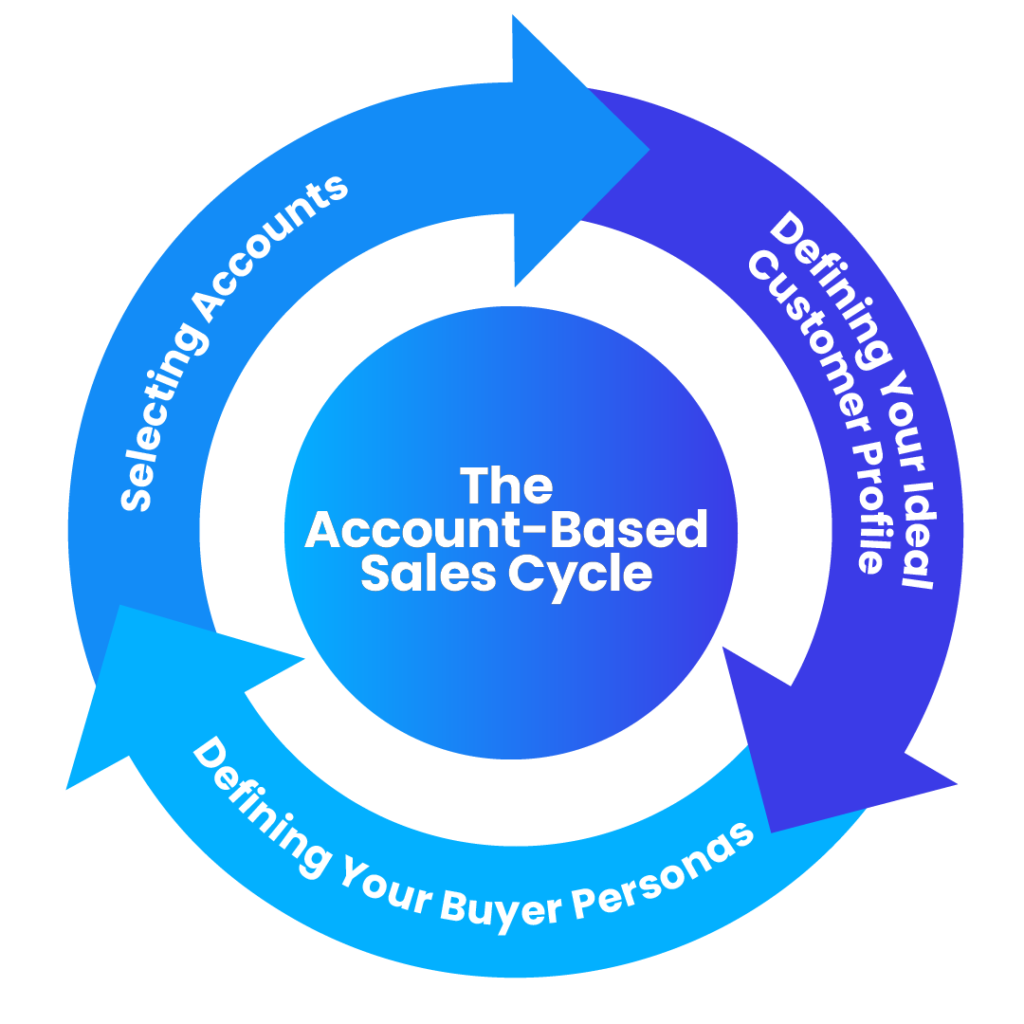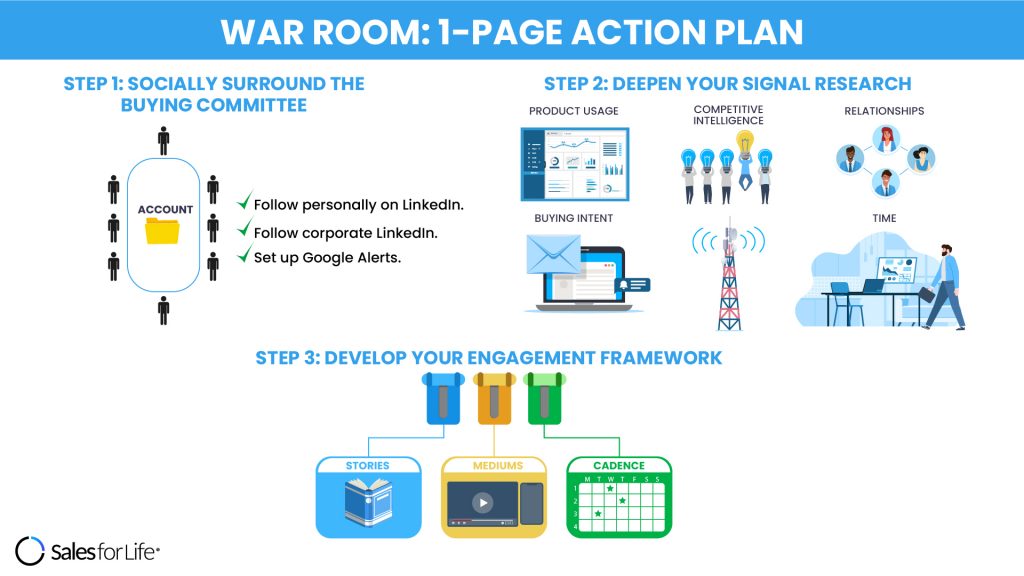Contact
2 Bloor Street West
Suite 700
Toronto, Ontario
M4W 3E2
Canada
support@salesforlife.com Toll-free: (877) 367-9216
Chapter 1


However, account-based selling could be a good approach if you’re targeting mid-market enterprises. As long as your average deal size is at least $50,000, an account-based approach could accelerate growth.
“The companies that leverage an account-based sales motion are ones that have now achieved scale,” says Jamie Shanks, Sales for Life’s Managing Partner.
“These are organizations where the inbound lead flow has become sufficient, but not targeted enough to focus directly on the ideal customer profile that will help them grow effectively, meaning that either the inbound lead flow is not targeted to the right size of customer, not targeted to the right geographic verticalized markets. And thus, the only way to achieve growth is to identify the companies that can pay the right lifetime value for your solution to be able to effectively grow your business.”

ou will be less likely to experience customer churn when your messaging is clear and consistent and when our claims can be backed with proof. The open-ended life cycle of your customers also provides your sellers with several opportunities to upsell and/or cross-sell, making account-based selling the best approach if you offer a variety of packages, tiers, add-ons, or complementary services.
On the other hand, if your service is a one-time purchase product, it would be better to explore other possibilities before committing to an account-based sales strategy.
Chapter 2

01
Predictable Revenue Growth
1. Predictable Revenue Growth
Usually, pipeline value is determined after an initial call with a prospect. This can be time-consuming and will put the ball in the court of the prospect. With account-based selling, Since your sellers will only target the accounts your business needs, they will have more control over how they spend their time.

02
Greater Revenue Growth Trajectory
2. Greater Revenue Growth Trajectory
Targeting high-value accounts allows for more time researching and creating highly personalized messaging for a higher close rate.

03
Strategic, Systematic Selling
3. Strategic, Systematic Selling
Account-based selling allows you to be more strategic in how you approach, research, plan, and execute each step of your sales method. Instead of prioritizing volume in your strategy, you can take the time to be more strategic and methodically plan out every step.
04
Easier Performance Tracking
4. Easier Performance Tracking
Account-based selling is focused on efficiency and effectiveness, tracking how goals are being accomplished and how milestones are being hit across the accounts your sellers are targeting. Since you’re only focusing on a few customers, it’s easier to track, process, and manage fewer account transactions, giving you more visibility into what is working and what’s not.

05
Better Brand Reputation
5. Better Brand Reputation
Since accounts are pre-qualified and you’re taking more time with messaging, you are no longer interrupting prospects, and you’re creating more value with each interaction.

06
Improved Department Alignment
6. Improved Department Alignment
Adopting an account-based strategy are a great way to align the efforts of not just your sales and marketing teams, but the whole revenue department. This uniform approach ensures that everyone is on the same page, smoothly directing information and innovation to the sales team.
Chapter 3
There are a number of different names for the account-based model:
All refer to a relatively similar approach: Sales, marketing, and other relevant teams working together to close targeted, individual accounts using an approach that’s unique to that client’s needs.
No matter what you call it, this approach isn’t altogether new: Enterprise salespeople have used an account-level approach for a long time.

But as Engagio CEO and founder Jon Miller explains, “There are no ‘hand-offs’ in an Account-Based Everything model. Instead, Marketing and Sales work together from the very start, and throughout the revenue cycle.”
Businesses are targeted within a market using distinctly defined marketing data, for example, personalized promotions designed to resonate with each prospect.

Account-Based Selling

Account-Based Marketing
An effective account-based strategy begins with the alignment of the sales and marketing teams. Otherwise, all your efforts are bound to fall apart.
On the bright side, an account-based sales strategy forces your sales and marketing teams to work together instead of against each other, naturally leading to a more harmonious relationship between the two teams. But since this isn’t always the case, here are some ways you can get the two teams to cooperate:
Chapter 4

Time is finite. In fact, 83 percent of sellers don’t make quota because of poor time management.
Your sellers should spend their time on accounts that have the highest chances of growing and preventing churn. Simply targeting accounts without clear and strong evidence is not an enduring strategy.
Each sales organization has its own way of selecting accounts. They could pick from lists of Fortune 500 companies, review historical spending and growth data. But the best account selection strategies have these in common: A clearly defined ideal customer profile and detailed buyer personas.
Your ICP is a fictitious entity that has all the characteristics that make it the perfect customer of your organization, guiding sellers in targeting accounts that fit your target market.
A well-crafted ICP helps align your solution to your customers’ needs, define and troubleshoot issues and potential problems, and guides the future updates and changes that will be made to your product.
Why is an Ideal Customer Profile Important?
Spending time and effort on every lead you encounter isn’t a good use of your sellers’ time. There will always be some leads that would be a better fit for your organization, and it’s crucial to identify them as early as possible to conserve your sales team’s time and energy. This is where your ICP comes in handy, acting as a template that you can use to quickly compare accounts to.
After identifying accounts that fit your ICP, you need to ensure that your sellers know whom to talk to and how to field inquiries about your solution or organization. Keep in mind that questions and priorities will vary depending on an individual’s role within the organization, their knowledge of the product, and their level of experience. Creating buyer personas can help paint a better picture of the people you’re targeting.
On the other hand, buyer personas provide structure and context for your organization’s sales strategy by giving a generalized representation of your individual customers.
Buyer personas not only account for your customer demographics, but also define your prospect’s goals, motivations, and problems. These reasons make buyer personas necessary for planning the allocation of your team’s resources and the curation of your content.
When determining the number buyer personas your organization needs, remember that there’s no need to create one for each job title that your sales team encounters.
While the usual route is to create job-specific personas, such as Marketing Executive Mandy or Sales Manager Steve, you should also consider creating personas based on the challenges that people are facing. By creating challenge-based personas such as Fresh Grad Randy, Tech Geek Trina, and Start-up Savvy Stella, your team can better address the issues and problems their clients encounter and choose the most appropriate ways to show how your product can solve them.
Defining both your ICP and buyer personas can help one another.
ICPs and buyer personas, though different, are closely connected and are both crucial to an organization’s sales strategy. Ideally, your ICP should have a few buyer personas that your team creates content for and feels comfortable communicating to.
Your ICP advises your company about the accounts that should be targeted by clearly defining the qualities that are needed, while your buyer personas inform your sellers about the kind of people they are prospecting to and creating content for, as well as the questions they could ask.
The ICP is best used when qualifying leads at the beginning of the sales cycle. This way, your sellers could avoid wasting their time and effort on leads that won’t close because of their company size, their annual revenue, or other factors.
When they have determined which leads to prioritize, the buyer personas will determine how to approach the decision makers within the account by creating content that addresses their challenges and habits.
In short, your ICPs will determine account selection, while the buyer personas you create will affect how your sellers will communicate with the individuals that comprise the account’s buying committee.
Chapter 5
Focused, standardized prospecting is the key to growing your sales pipeline.
By prioritizing contacts that have a higher likelihood of responding warmly to you, your team can increase their opportunities to win.
While your sellers can’t force a customer to buy against their schedule, there are certain events and insights that distinguish the most promising target accounts from the rest of the pack. These events and insights are called Signals and they can help your team determine areas of opportunity and risk in your Total Addressable Market (TAM). This allows them to spend more time on activities that have a higher likelihood of producing results.
Signals can do wonders for your sales pipeline, but your team must know how to recognize and accordingly act upon them. They aren’t a one-size-fits-all solution to your team’s prospecting woes—your team needs to leverage them in the right situation to attain the best results.
People join and leave companies all the time—and these could indicate where an organization’s priorities lie.
Such movements in your accounts are called Time Signals, and they can help your team better visualize an account’s state, allowing your sellers to develop sales plays in advance.
While your rivals can recreate your products and processes, doing the same for your network would not be an easy task.
By activating Relationship Signals, your team can find connections that they can leverage in order to gain a massive advantage over your competitors.
Competitive Signals help track the presence of your competitors and their influence on your target, named, or customer accounts.
These Signals will help your sellers make smarter decisions about time management, account prioritization, resource allocation, and risk possibility.
Buying Intent Signals, or Purchasing Intent, refer to the likelihood that a certain person will buy your product or service either now or in the near future.
These signals indicate if a prospect is still consuming information, is interested in your product, or if they’re ready to purchase. Understanding Buying Intent Signals will allow your sellers to segment leads according to interest level, enabling targeted, effective communication.
Most sellers choose accounts to target based on factors such as the size of the account, whether that’s by revenue, number of employees, or potential spending ability; the vertical that an account is in; its location; the perception others have of its success based on the news; the brand name, or a combination of several of these. But the main reason—at least, most of the time—is the account’s wallet size. If you believe that an account has money to spend, matching them with your solutions would be a win-win scenario.
However, there’s no way to ascertain if these factors will result in a positive outcome. But if someone in your seller’s inner circle of connections advises them to check something out, it’s a much different scenario.
Relationships and social proximity to information matter. Your sellers are much more likely to trust information from close friends, family, and advocates.
This is where the Sphere of Influence comes in. Consider this your custom relationship-based account selection process.
It’s estimated that nearly 75 percent of all sales deals happen because of relationships, and the Sphere of Influence helps reveal opportunities that could result from common relationships.
A target account list is a list of all accounts you will be targeting in your sales and marketing activities for the given period. It contains all details relevant to your ideal customer profile, and the buyer personas who you think would be a good fit for your product.
The more detailed your target account list is, the easier it will be to devise the relevant content and customer engagement activities.
You might face several challenges, like creating target account lists in a limited time duration and considering real-time events.
The best way to overcome these challenges and make sure your target account list is not based on outdated data is to combine your information with sales intelligence. This will help you target the right prospects at the right time.
Here are some examples of data that you can use to identify and build your target account list:
Account planning requires the mapping out of important details about your sale team’s new prospects or existing customers, including information about their decision-making processes, the companies you’re competing with to close a deal with them, and your team’s strategy to not just win them, but to also eventually retain and grow them.
At Sales for Life, the term “War Room” stands for an account planning framework for the pipeline-building phase of your sales cycle. It’s a one-page action plan with all the information your seller would need to know about an account. An effective War Room should address these three questions:
How can you propel forward your partnership with the account in a bold and different way, while governing your accountability to action?

Socially surrounding or researching key people in and connected with the account will allow you to know what matters to them. This works hand-in-hand with your war room creation efforts, elevating your sellers’ conversations with people in the account and empowering your team to build better relationships to grow pipeline.
“The concept of social surrounding means we’re trying to form digital relationships with people in the event that we can’t see them physically, as the reality is you can’t do site visits with every department,” says Shanks.
“And so we’re using tools like LinkedIn and other social platforms to connect with them to monitor their activities, to engage them, so we can keep the relationship warm in the event that two things happen.”
While metrics are important in all aspects of a business, it’s especially crucial in sales. Revenue leaders can’t just use their intuition to make decisions, as there’s a lot of money at stake and the risk of failure can be high.
You need to determine which numbers you need to pay attention to and set your targets accordingly.
Metrics include:
To hit the numbers you’ve set, your sales team would need to use tools. You might need to spend money on some of them, so you should ensure that the tools you select will be maximized by the whole team.
The best sales enablement tools have an easy-to-understand user interface, enable content creation, allow inter-departmental collaboration, can be integrated with your existing CRM and the other tools in your stack, include training and onboarding modules and schedules, and generate insights from data.
Assess your current tools to see what you lack, and proceed with your business’ unique needs in mind.
An effective content strategy for B2B sales requires delivering the right content to the right prospect at the right time. To convert prospects, your content should be tailored, timely and relevant, effectively addressing concerns and pain points and making an impact on the stakeholders of the account.
“Content has to resonate with what the buyer’s pain points are,” says Amar Sheth, Sales for Life’s COO.
“Content needs to solve problems. Content needs to have solutions that target current problems like painkillers do, instead of preventing future problems, which is what vitamins would do. Content really needs to cut through the clutter and tell people exactly what it is that they want.”
Before anything else, you first have to develop the buyer’s journey for your business. This is crucial for creating content that resonates with your buyers and building up your funnel so you can better communicate with them at every stage of their journey.
At this stage, the content you should create should be able to start conversations that can lead to meaningful relationships with the right people.
Content should be easy to discover and consume, and should lead to a solution for their problems or pains.
Some content you could create:
Here, the leads you’re dealing with have defined their problem and are actively looking for products and services that can address their issues.
The type of content that can serve your leads at this stage includes the following:
Here, your leads are ready to purchase the best solution that can solve their problems—and they’re considering your product or service. At this stage, they would need content that would convince them why your solution is the best solution.
This is where you should go all out and tell the world how amazing your product is and what exactly it can do that others cannot.
You can achieve this with these types of content:
One thing that differentiates B2B from B2C is that a steady stream of customers will not ensure your company’s survival. B2B customers generally stick to a product or a solution for longer periods, only investing after a long period of evaluation.
You will need to continuously give your customers concrete reasons to choose your product over and over instead of switching to your competitors.
Storyboarding brings your engagement framework to life.
As mentioned in the previous section, visualizing your buyer’s journey is crucial in order to properly and effectively address their concerns.
Creating a storyboard—a multi-story, multi-touch plan—for each focus account will enable your sellers to think of their communication strategically, focusing on what really matters and bringing structure to their outreach efforts.
A storyboard also acknowledges that multiple mediums and touchpoints are needed to open doors and start conversations, allowing your team to track which efforts generate positive results and which ones should be scrapped.
Here are some activation strategies that are often employed by B2B teams:
Personalized communication is vital to your business’ success.
Majority of business buyers expect companies to anticipate their needs and deliver personalized experiences similar to what they would receive from B2C companies.
Your sellers should keep track of your customers’ preferences and give them not just what they want, but what they need.
This can be done in several ways: You can have your website show content according to your customers’ demographics, interests, and search history; showing personalized ads, and sending personalized emails and social media messages.
This encourages customers to become advocates of your brand in exchange for rewards or discounts, further attracting new clients through word-of-mouth.
You can also offer reduced pricing or free additional services for clients who would like to renew their contract with you.
A newsletter that’s tailored to your target account’s needs and pain points can effectively grab their attention.
Marketing automation platforms allow you to automate and personalize your newsletter messages for every stage of the sales funnel.
This is a tried-and-true method of activation that actually delivers results, especially for software or technical products.
You can offer a free trial for a few days to a month—enough time for a prospect to tinker around your solution and see if it works for them.
If you have a new product or feature, you can upsell it to your existing customers by asking to offer them a demonstration.
They are more likely to say yes since they already have experience with your company, and, provided your service is good, would be more open to seeing what else you can offer.
These events reinforce brand authority, affirming your clients’ belief that they made a good decision to sign with you.
These events are also a great way to introduce your company to new audiences, some of which could be key stakeholders in your target accounts.
The VP of Sales oversees and manages your account-based campaigns. Since they make sure your team attains the goals and quotas you have set, they need to be talented managers who can motivate their team well.
The VP of Sales is, by default, your most impressive player when you need to impress big clients. They can also be your chief brand evangelist due to the influence they yield. This requires them to maintain an active social media presence, becoming an industry thought leader so they can further build your brand’s awareness.
The VP of Sales’ main responsibilities are to build product awareness, secure partnerships, and expand overall brand authority. Your company would greatly benefit from having a vocal thought leader and brand advocate as its VP of Sales.
Your Account Sales Executives serve as the primary salespeople of your account-based sales team.
Their responsibilities include meeting prospective accounts, closing deals with customers, and prospecting for new accounts with your Business/Sales Development team.
The BDRs or SDRs are responsible for most of your outreach efforts, scheduling client meetings and product demos, testing email sequences, writing sales call scripts, and handling inquiries and follow-ups.
You need people who know their way around data to help your team make sense of all your information and extract insights that will make your outreach efforts more valuable to users.
Your data analysts will use your data to analyze seller and program performance, develop key performance indicators, monitor trends, make predictions , find areas that can be improved, and create reports.
Using storytelling techniques in your sales efforts can benefit your bottom line, hooking in your customer earlier and connecting with them better.
An account-based content marketer can help you with your storytelling efforts by creating and promoting content that addresses your buyers’ pain points and questions, at the same time providing your sellers with valuable knowledge to start or continue a conversation.
Your work doesn’t stop when you’ve acquired an account. You will also need to take care of your accounts after securing them.
Your support representatives will be in charge of keeping the whole team updated on your accounts, and they will address any issues that arise.
Chapter 6
Earlier, we’ve touched on the importance of deciding which metrics to focus on and setting targets for each one.
Sales metrics represent your revenue team’s performance, helping track progress towards goals, prepare for future growth plans, identify and work around strategic issues, and award incentives and bonuses.
All sales teams should know their numbers for the following metrics:
When working with metrics, make sure to address the following questions:
Coverage:
Awareness:
Engagement:
Reach:
Revenue Influence:
Chapter 7
Chapter 8
The core concept behind account-based sales is to target high-value customers and craft strategies that help you connect better with your prospective customers.
Account-based sales bring success through focused strategies that help manage the time and resources of the organization effectively. Sales representatives can now focus on customers with the highest likelihood of conversion and thus make the best use of time and resources.
As sales reps build an account plan and build their marketing strategy around the account, they get a better perspective on what brings better conversions and opportunities. Identifying the target audience can thus help the sales reps refine their capabilities for providing better customer engagement.
Account-based selling provides a way to deliver highly personalized sales operations that can be hugely beneficial to B2B companies that need to provide high-value engagements and make quick responses and decisions with respect to each of their high profile accounts.
No one works individually in an account-based sales strategy. The whole of the organization is involved with the sales and marketing team alignment being very crucial to the success of the ABS strategy.
Although it is not easy to execute, your revenue team can definitely make things work with the right planning and collaboration across your organization. The important task here is to understand the goals, identify the requirements of your customers, and equip yourself with the right data so you can assist your accounts depending on their customer journey and buyer persona.
Subscribe to receive more sales insights, analysis, and perspectives from Sales For Life.

